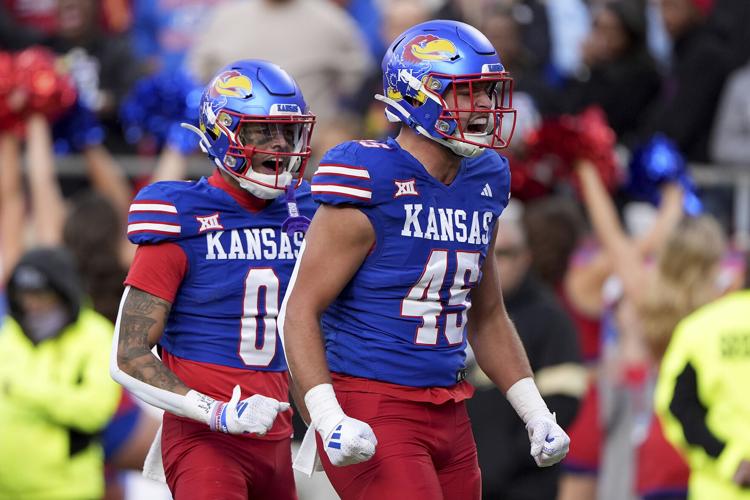Reaction to Week 13 developments for teams around the West …
1. Big 12: on brand
The Big 12 title chase is utter mayhem, but one thing is clear: The conference championship on Dec. 7 won’t match the two best teams.
One of them cannot qualify.
Kansas is playing as well as anyone in the conference and hammered No. 16 Colorado on Saturday to complete the trifecta following victories over No. 24 Iowa State and No. 14 BYU the previous two weeks. (And they were 16 seconds away from upsetting No. 21 Arizona State in early October.)
The Jayhawks are the first team with a losing record to defeat three consecutive ranked opponents in major college history.
Nobody in the Big 12 wants to play the Jayhawks — not after they rushed for 331 yards and corralled Colorado’s passing game in the second half of a 37-21 victory.
But the Jayhawks (5-6 overall/4-4 Big 12) lost their first three conference games and were eliminated from the race a month ago.
So the hottest team in the Big 12 not named Arizona State cannot qualify for the championship.
Meanwhile, the Sun Devils (9-3/6-2) control their own destiny after repelling BYU 28-23 in Mountain America Stadium. (Their six-win improvement over last season is the largest year-over-year increase in school history.)
If the Devils beat Arizona on Saturday afternoon in Tucson, they will advance to the championship game.
Amazingly, the team picked 16th in the Big 12 preseason poll is four quarters from playing for the conference title.
2. The tiebreaker weeds
Thanks to ASU, there is some semblance of clarity within the four-team tie atop the Big 12 standings.
Let’s plunge into the weeds of the conference tiebreaker process that was designed to sort through exactly this type of chaos.
If we account for all potential losses next weekend, there are simply too many permutations to consider.
So let’s keep things simple and assume the four teams currently tied for first place (ASU, BYU, Colorado and Iowa State) all win their finales and finish with 7-2 records in conference play.
In that situation, the Sun Devils would advance to face Iowa State for the Big 12 title with a berth in the College Football Playoff at stake.
Here’s how:
The head-to-head tiebreaker would not apply, so the process would move to the second step: record against common opponents.
ASU would finish with a 4-0 record against the opponents common to all the tied teams and thus become the No. 1 seed.
BYU and Iowa State would be tied at 3-1 and remain in the tiebreaker process.
Colorado, with a 2-2 record against common opponents, would be eliminated.
The tiebreaker would start over with only BYU and Iowa State involved. There is no head-to-head result to consider; they have the same record against common opponents; and they have the same common loss (Kansas). At that point, the tiebreaker would move to the fourth step: strength-of-schedule in conference games.
The edge in that category goes to Iowa State, according to the Big 12.
The Sun Devils and the Cyclones playing for the conference championship — and a playoff berth — is the matchup we didn’t know we needed.
Whether that proves to be the matchup in Arlington next month or Colorado faces BYU or another pairing materializes, the Big 12 is on brand.
The conference with no blue bloods but stupendous parity has four teams alive on the final weekend. Unless more chaos emerges and additional teams get pulled into the mix. Anyone interested in an eight-team tie?
3. Cal claws back
Two 90-yard touchdown drives seven weeks apart have defined the football season in Berkeley.
The first came courtesy of Miami, which covered 92 yards in the final minutes to cap a come-from-nowhere 39-38 victory over the Bears in early October.
That gut-punch loss stripped Cal of its early-season momentum and seemed to produce a multi-game hangover that left the Bears with a narrow path into the postseason.
The second momentous mega-drive unfolded Saturday afternoon, when the Bears covered 98 yards late in the fourth quarter to complete a two-touchdown rally and defeat Stanford for the fourth consecutive season.
Without their 24-21 escape from Stanford’s upset bid, the Bears (6-5) would have faced a must-win game in the season finale at SMU.
Instead, their bowl berth is secured.
Technically, this will be the Bears’ fourth bowl appearance in the past seven years. In reality, it will be their fourth in the past five years.
Don’t forget that COVID walloped the Bears for two seasons, not one, because of the severe, prolonged restrictions imposed by Berkeley Public Health.
Given the impediments to consistent success at Cal, the sweep of Justin Wilcox’s eight-year tenure has been an unqualified success.
4. An OSU awakening
Just when we thought Oregon State was done for 2024, the Beavers rose up to take down Washington State on Saturday night and win the only Pac-12 conference game of the season.
Their riveting 41-38 victory easily met the Power Five standard despite the relegated status given to the conference and its two member schools.
OSU trailed by seven points late but scored on a 75-yard touchdown drive, forced a WSU turnover, then celebrated when Everett Hayes drilled a 55-yard field goal with 20 seconds remaining.
The victory snapped a five-game losing streak that included dismal performances against Cal, San Jose State and Air Force.
It also kept OSU’s postseason hopes alive, barely.
The Beavers (5-6) must win Friday at Boise State to secure a bowl berth.
But win or lose on the blue turf, the victory over WSU will make the offseason far more palatable for coach Trent Bray and his staff.
5. Crosstown script flip
The final Power Four game of the penultimate Saturday of the regular season featured two notable plot twists: Not only did USC rally from a fourth-quarter deficit to defeat UCLA, but the Trojans did it with stout defense.
After bungling one late lead after another on their way to a deeply disappointing season, the Trojans scored the final 10 points in the Rose Bowl to secure a 19-13 victory in the Crosstown Showdown.
The key play: A fourth-and-one stop by USC’s defense with five minutes remaining.
As a result, the Trojans (6-5) will go bowling regardless of the outcome of their season finale against Notre Dame.
That won’t extinguish the fan frustration with coach Lincoln Riley, especially if USC loses to the Irish. But it gives the administration traction behind the decision to retain Riley (presuming it wants him back).
UCLA’s season is over. Not officially, of course. (The Bruins play Fresno State next weekend.) But they have been eliminated from the postseason after back-to-back losses to Washington and USC sealed a losing record.
If you’re scoring at home, however, it’s reasonable to conclude that UCLA (4-7) came closer to maximizing its potential than USC as the schools navigated their new existence.
The Trojans had their sights on the College Football Playoff, especially after the Week 1 victory over LSU. Instead, the season devolved into a weekly exercise in finding ways to lose.
Not what the school envisioned for its inaugural season in the Big Ten.





